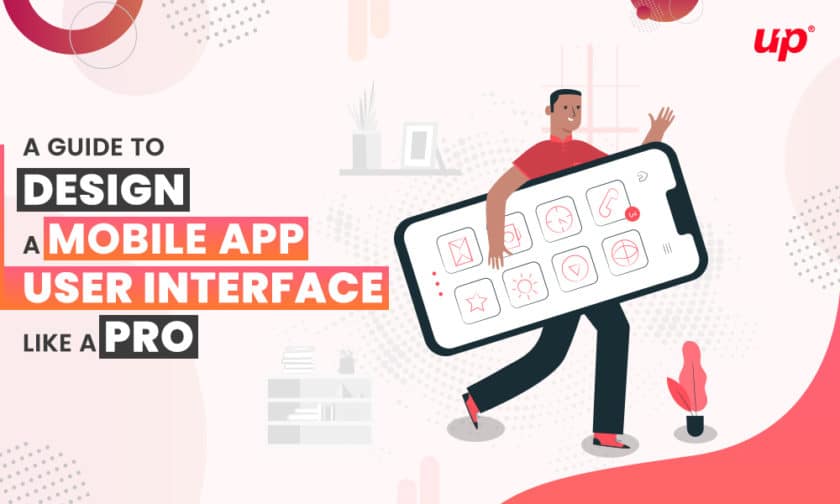A Guide to Design a Mobile App User Interface like a Pro

TechsPlace | While it’s definitely true that mobile app has come quite a long way in the decade-or-so since Steve Jobs first introduced the iPhone to the world, there is still one significant idea that is just as true today as it was in 2007.
The dissimilarity between a mobile app UI and a good mobile app UI is a significant one, certainly.
In this guide, we will provide an overview of some of the most significant principles to follow when designing your own mobile app. This will comprise of a discussion of how you can also not only conceive of and build requirements for designs but how to then implement those custom website designs and test them moving forward.
Also commonly referred to as heuristics, it’s important to understand that design principles are not necessarily written in stone. Instead, they are loose guidelines that designers can stick to in order to improve the quality of their user interface- all while still allowing room for their own creativity to thrive. They are recommendations, but they are good ones- and ones that will let you accelerate your delivery time of a higher quality finished product, as well.
- The Essential UI Design Principles:
When taken together, all of the design principles listed below combine to form something much more powerful than any one of them could be on their own- and something that will make your life far easier as a UI designer. Collectively, they help remove a lot of the guesswork that normally comes with mobile app design and make interfaces more predictable and as a result, easier to use for everyone.
The most important UI design principles that you should know about include ones like:
- The structure principle: This is the idea that tells us your design choices should always be organized in a purposeful way. Their intent and impact should be clear and everything should be based on the immediate and recognizable needs of end-users.
- The simplicity principle: This principle is all about making sure your design is simple, clear, and easy to use. What a button should be immediately obvious to the user. Common tasks should be grouped together for convenience etc.
- The visibility principle: This is all about making sure that the core functionality of your app is easily available to end-users. Every option that someone needs to perform a task should be front and center, without letting distracting design choices get in the way.
- The feedback principles: This reminds us that designers should always keep end-users informed of not only actions or interpretations of functionality, but also states and conditions well.
- The tolerance principle: This is critical, as it recommends that your creative web design services should be flexible as it is tolerant. By allowing undoing and redoing, you can not only reduce the cost of your initial mistakes- but you can also prevent errors whenever possible, too.
- The reuse principle: Finally, this argues for the sake of true consistency- rather than arbitrary consistency. Essentially, the design should reuse internal and external components and behaviors. If you release two apps that include the same feature should work identically in both instances so that users don’t have to suddenly learn two completely different ways of doing this.
Likewise, testing needs to be done at each stage of the user experience design process, provided that you have the time to do so. This means testing not only after thumbnail sketches but also wireframes, high fidelity mock-ups, prototypes and beyond.
This can be a formal test, sure- but it can also be as simple as asking someone for their opinion. The point is that you test whenever you have the chance to do so as user experience design is all about a delicate balance between what you’re trying to do and what the data in front of you is telling you to do.
- What are we Actually Building and How do We Build it?
Before you even think about getting out of the sketchbook to mock up some ideas, there are a number of basic questions you need to ask yourself.
First, the overall functions of the app need to be based on the answer to the question “What are we building in the first place?” Why are you designing this app, and what do users need it to be able to do? Every decision you make needs to be dedicated by that same core group of people.
For instance, It’s given that your app will have a home screen but do you need functionality in different languages? Are you dealing with in-app purchases? How can users view content they’ve already purchased easily versus content that they can purchase in the future? All this will be answered by asking yourself “what are we actually building?”
Remember that a mobile app user interface needs to do more than just look nice. It needs to be easy to use and enjoyable to engage with. If you don’t test your decision choices based on these core criteria, rest assured that you’re probably going to be making some bad ones along the way.
Conclusion
At that point, a large part of the “hard work” had already been done. You’ve thoughtfully designed, tested and have fun begun to build that mobile app user design and you’ve mitigated a lot of mistakes along the way. Success moving forward is all about falling back on some of the “tried but true” principles of mobile app design.
Anshul Sharma is CEO of Fluper, leading mobile app Development and web Design Company. His visionary management style has yield productive results for the company. He believes in contributing his strong knowledge base with a leaned concentration on entrepreneurship and business.





